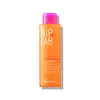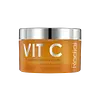What's inside
What's inside
 Key Ingredients
Key Ingredients

 Benefits
Benefits

 Concerns
Concerns

 Ingredients Side-by-side
Ingredients Side-by-side

Water
Skin ConditioningGlycerin
HumectantButylene Glycol
HumectantLactic Acid
BufferingPolysorbate 20
EmulsifyingPhenoxyethanol
PreservativeAscorbic Acid
AntioxidantBenzyl Alcohol
PerfumingSodium Hydroxide
BufferingParfum
MaskingDisodium EDTA
Panthenol
Skin ConditioningSodium Sulfite
PreservativeEthylhexylglycerin
Skin Conditioning1-Methylhydantoin-2-Imide
Skin ConditioningDehydroacetic Acid
PreservativeLimonene
PerfumingCamellia Sinensis Leaf Extract
AntimicrobialCoffea Arabica Seed Extract
MaskingEuterpe Oleracea Fruit Extract
Garcinia Mangostana Fruit Extract
Skin ConditioningHydrolyzed Lycium Barbarum Fruit Extract
AntioxidantMorinda Citrifolia Fruit Extract
Skin ConditioningPunica Granatum Fruit Juice
MaskingWater, Glycerin, Butylene Glycol, Lactic Acid, Polysorbate 20, Phenoxyethanol, Ascorbic Acid, Benzyl Alcohol, Sodium Hydroxide, Parfum, Disodium EDTA, Panthenol, Sodium Sulfite, Ethylhexylglycerin, 1-Methylhydantoin-2-Imide, Dehydroacetic Acid, Limonene, Camellia Sinensis Leaf Extract, Coffea Arabica Seed Extract, Euterpe Oleracea Fruit Extract, Garcinia Mangostana Fruit Extract, Hydrolyzed Lycium Barbarum Fruit Extract, Morinda Citrifolia Fruit Extract, Punica Granatum Fruit Juice
Water
Skin ConditioningPropylene Glycol
HumectantBis-PEG-18 Methyl Ether Dimethyl Silane
EmollientSodium Lactate
BufferingGlycolic Acid
BufferingCitrus Sinensis Fruit Extract
AntioxidantLactic Acid
BufferingPhenoxyethanol
Preservative3-O-Ethyl Ascorbic Acid
Skin ConditioningSalicylic Acid
MaskingDisodium EDTA
Ethylhexylglycerin
Skin ConditioningAlcohol Denat.
AntimicrobialAnanas Sativus Fruit Extract
Skin ConditioningPassiflora Quadrangularis Fruit Extract
Skin ProtectingVitis Vinifera Fruit Extract
Skin ConditioningSodium Sulfite
PreservativePunica Granatum Extract
AstringentParfum
MaskingCitral
PerfumingLimonene
PerfumingWater, Propylene Glycol, Bis-PEG-18 Methyl Ether Dimethyl Silane, Sodium Lactate, Glycolic Acid, Citrus Sinensis Fruit Extract, Lactic Acid, Phenoxyethanol, 3-O-Ethyl Ascorbic Acid, Salicylic Acid, Disodium EDTA, Ethylhexylglycerin, Alcohol Denat., Ananas Sativus Fruit Extract, Passiflora Quadrangularis Fruit Extract, Vitis Vinifera Fruit Extract, Sodium Sulfite, Punica Granatum Extract, Parfum, Citral, Limonene
Ingredients Explained
These ingredients are found in both products.
Ingredients higher up in an ingredient list are typically present in a larger amount.
Disodium EDTA plays a role in making products more stable by aiding other preservatives.
It is a chelating agent, meaning it neutralizes metal ions that may be found in a product.
Disodium EDTA is a salt of edetic acid and is found to be safe in cosmetic ingredients.
Learn more about Disodium EDTAEthylhexylglycerin (we can't pronounce this either) is commonly used as a preservative and skin softener. It is derived from glyceryl.
You might see Ethylhexylglycerin often paired with other preservatives such as phenoxyethanol. Ethylhexylglycerin has been found to increase the effectiveness of these other preservatives.
Lactic Acid is another well-loved alpha hydroxy acid (AHA). It is gentler than glycolic acid but still highly effective.
Its main role is to exfoliate the surface of the skin by loosening the “glue” that holds dead skin cells together. Shedding those old cells leads to smoother, softer, and more even-toned skin.
Because lactic acid molecules are larger than glycolic acid, they don’t penetrate as deeply. This means they’re less likely to sting or irritate, making it a great choice for beginners or those with sensitive skin.
Like glycolic acid, it can:
Lactic acid also acts as a humectant (like hyaluronic acid). It can draw water into the skin to improve hydration and also plays a role in the skin's natural moisturizing factor (NMF) in the form of sodium lactate.
Studies show it can boost ceramide production to strengthen the skin barrier and even help balance the skin’s microbiome.
To get results, choose products with a pH between 3-4.
Lower strengths (5-12%) focus on surface exfoliation; higher strengths (12% and up) can reach deeper in the dermis (deeper, supportive layer) to improve skin texture and firmness over time.
Though it was originally derived from milk, most modern lactic acid used in skincare is vegan. It is made through non-dairy fermentation to create a bio-identical and stable form suitable for all formulations.
When lactic acid shows up near the end of an ingredient list, it usually means the brand added just a tiny amount to adjust the product’s pH.
Legend has it that Cleopatra used to bathe in sour milk to help reduce wrinkles.
Lactic acid is truly a gentle multitasker: it exfoliates, hydrates, strengthens, and brightens. It's a great ingredient for giving your skin a smooth, glowing, and healthy look without the harshness of stronger acids.
Read more about some other popular AHA's here:
Learn more about Lactic AcidLimonene is a fragrance that adds scent and taste to a formulation.
It's found in the peel oil of citrus fruits and other plants such as lavender and eucalyptus. The scent of limonene is generally described as "sweet citrus".
Limonene acts as an antioxidant, meaning it helps neutralize free radicals.
When exposed to air, oxidized limonene may sensitize the skin. Because of this, limonene is often avoided by people with sensitive skin.
The term 'fragrance' is not regulated in many countries. In many cases, it is up to the brand to define this term. For instance, many brands choose to label themselves as "fragrance-free" because they are not using synthetic fragrances. However, their products may still contain ingredients such as essential oils that are considered a fragrance.
Learn more about LimoneneParfum is a catch-all term for an ingredient or more that is used to give a scent to products.
Also called "fragrance", this ingredient can be a blend of hundreds of chemicals or plant oils. This means every product with "fragrance" or "parfum" in the ingredients list is a different mixture.
For instance, Habanolide is a proprietary trade name for a specific aroma chemical. When used as a fragrance ingredient in cosmetics, most aroma chemicals fall under the broad labeling category of “FRAGRANCE” or “PARFUM” according to EU and US regulations.
The term 'parfum' or 'fragrance' is not regulated in many countries. In many cases, it is up to the brand to define this term.
For instance, many brands choose to label themselves as "fragrance-free" because they are not using synthetic fragrances. However, their products may still contain ingredients such as essential oils that are considered a fragrance by INCI standards.
One example is Calendula flower extract. Calendula is an essential oil that still imparts a scent or 'fragrance'.
Depending on the blend, the ingredients in the mixture can cause allergies and sensitivities on the skin. Some ingredients that are known EU allergens include linalool and citronellol.
Parfum can also be used to mask or cover an unpleasant scent.
The bottom line is: not all fragrances/parfum/ingredients are created equally. If you are worried about fragrances, we recommend taking a closer look at an ingredient. And of course, we always recommend speaking with a professional.
Learn more about ParfumPhenoxyethanol is a preservative that has germicide, antimicrobial, and aromatic properties. Studies show that phenoxyethanol can prevent microbial growth. By itself, it has a scent that is similar to that of a rose.
It's often used in formulations along with Caprylyl Glycol to preserve the shelf life of products.
Sodium Sulfite is a preservative. Preservatives help prevent mold and bacteria from growing in cosmetics.
This ingredient has been shown to break the bonds in hair, acting as a natural straightener.
It is commonly used in food. It should be noted sodium sulfite degrades both vitamins B1 and E.
Fun fact: Sulfites are naturally occuring in wine.
Learn more about Sodium SulfiteWater. It's the most common cosmetic ingredient of all. You'll usually see it at the top of ingredient lists, meaning that it makes up the largest part of the product.
So why is it so popular? Water most often acts as a solvent - this means that it helps dissolve other ingredients into the formulation.
You'll also recognize water as that liquid we all need to stay alive. If you see this, drink a glass of water. Stay hydrated!
Learn more about Water